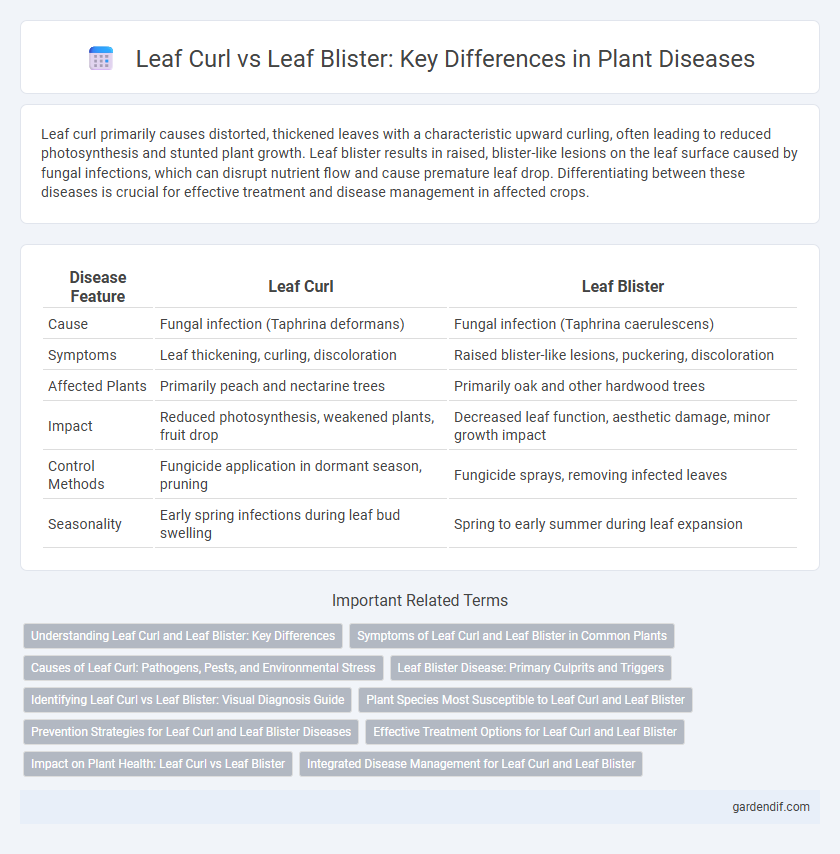
Leaf curl vs Leaf blister Illustration
Leaf curl primarily causes distorted, thickened leaves with a characteristic upward curling, often leading to reduced photosynthesis and stunted plant growth. Leaf blister results in raised, blister-like lesions on the leaf surface caused by fungal infections, which can disrupt nutrient flow and cause premature leaf drop. Differentiating between these diseases is crucial for effective treatment and disease management in affected crops.
Table of Comparison
| Disease Feature | Leaf Curl | Leaf Blister |
|---|---|---|
| Cause | Fungal infection (Taphrina deformans) | Fungal infection (Taphrina caerulescens) |
| Symptoms | Leaf thickening, curling, discoloration | Raised blister-like lesions, puckering, discoloration |
| Affected Plants | Primarily peach and nectarine trees | Primarily oak and other hardwood trees |
| Impact | Reduced photosynthesis, weakened plants, fruit drop | Decreased leaf function, aesthetic damage, minor growth impact |
| Control Methods | Fungicide application in dormant season, pruning | Fungicide sprays, removing infected leaves |
| Seasonality | Early spring infections during leaf bud swelling | Spring to early summer during leaf expansion |
Understanding Leaf Curl and Leaf Blister: Key Differences
Leaf curl, caused by fungal pathogens such as Taphrina deformans, leads to distorted, thickened, and curled leaves primarily affecting peach and nectarine trees. Leaf blister is characterized by raised, blister-like galls on leaves caused by fungi like Taphrina padi, commonly impacting stone fruit trees including cherries and plums. Distinguishing factors include the type of fungus involved, symptom appearance, and specific host plants, which are crucial for accurate diagnosis and effective disease management.
Symptoms of Leaf Curl and Leaf Blister in Common Plants
Leaf curl symptoms in common plants manifest as thickened, distorted, and curled leaves with a puckered appearance, often accompanied by reddish or yellowish discoloration and premature leaf drop. In contrast, leaf blister presents as raised, blister-like swellings on the leaf surface, typically associated with pale or yellowish spots, leading to tissue deformation and potential necrosis. Identifying these distinct symptoms aids in accurate disease diagnosis and effective management strategies for affected plants.
Causes of Leaf Curl: Pathogens, Pests, and Environmental Stress
Leaf curl is primarily caused by plant pathogens such as Taphrina deformans, a fungal agent that infects leaves and causes characteristic curling and discoloration. Insect pests like aphids and mites also contribute by feeding on leaf sap, leading to distorted growth and increased susceptibility to infection. Environmental stresses including extreme temperatures, drought, and nutrient imbalances further exacerbate leaf curl symptoms by weakening plant defenses and disrupting normal leaf development.
Leaf Blister Disease: Primary Culprits and Triggers
Leaf blister disease is primarily caused by the fungus Taphrina deformans, which targets peach and nectarine trees, leading to characteristic blister-like swellings on leaves. Environmental triggers such as prolonged wetness and cool temperatures during early spring create ideal conditions for fungal spores to germinate and infect host tissues. Effective disease management involves timely fungicide applications and cultural practices that reduce leaf wetness and improve air circulation.
Identifying Leaf Curl vs Leaf Blister: Visual Diagnosis Guide
Leaf curl is characterized by upward or downward curling of leaves accompanied by discoloration and thickening, often caused by fungal pathogens like Taphrina deformans. Leaf blister presents as raised, blister-like swellings on the leaf surface with a yellowish or pale green hue, typically resulting from Taphrina species infection. Accurate visual diagnosis hinges on noting the specific deformation patterns and affected areas, distinguishing leaf curling deformation from the blister-like protrusions.
Plant Species Most Susceptible to Leaf Curl and Leaf Blister
Tomato, cotton, and peach plants are most susceptible to leaf curl, with the disease caused primarily by the Tomato leaf curl virus and Peach leaf curl fungus. Leaf blister predominantly affects broadleaf trees such as oak, beech, and alder, caused by fungi like Taphrina species. Both diseases lead to significant crop and ornamental plant damage, emphasizing the need for species-specific management strategies.
Prevention Strategies for Leaf Curl and Leaf Blister Diseases
Effective prevention strategies for leaf curl involve regular application of fungicides containing copper or neem oil before disease onset, alongside the removal of infected leaves to minimize spore spread. For leaf blister, maintaining proper tree nutrition, ensuring adequate irrigation, and pruning to improve air circulation significantly reduce infection risk. Employing resistant plant varieties and practicing crop rotation further enhance prevention against both leaf curl and leaf blister diseases.
Effective Treatment Options for Leaf Curl and Leaf Blister
Effective treatment options for leaf curl include the application of fungicides containing copper or systemic fungicides like chlorothalonil or thiophanate-methyl, ideally during the dormant season for maximum efficacy. Leaf blister treatment often involves the use of horticultural oils and fungicides such as neem oil or sulfur-based products to reduce fungal spores and protect new growth. Consistent monitoring and maintaining tree health through proper pruning and sanitation are crucial for managing both diseases and preventing recurrence.
Impact on Plant Health: Leaf Curl vs Leaf Blister
Leaf curl causes severe distortion and thickening of leaves, leading to reduced photosynthesis and stunted growth in plants. Leaf blister results in raised, blister-like lesions on leaf surfaces, primarily affecting aesthetic quality with less impact on overall plant vitality. Both diseases compromise plant health, but leaf curl poses a greater threat by significantly impairing nutrient flow and development.
Integrated Disease Management for Leaf Curl and Leaf Blister
Integrated Disease Management for Leaf Curl and Leaf Blister combines resistant cultivars, timely fungicide applications, and cultural practices such as pruning and sanitation to reduce pathogen load. Effective monitoring and early detection enable targeted treatment, minimizing chemical usage and preventing disease spread. Crop rotation and maintaining plant health through balanced nutrition further enhance resistance against both diseases.
Leaf curl vs Leaf blister Infographic

 gardendif.com
gardendif.com